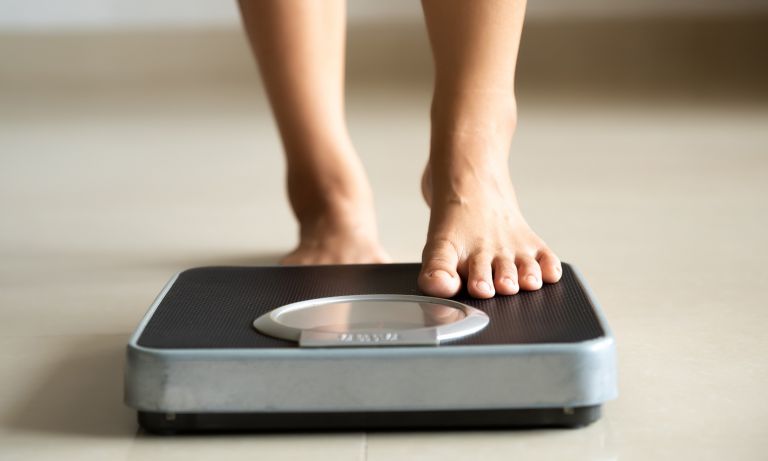
There are plenty of people claiming that intermittent fasting is the answer to everything from the obesity epidemic to cancer. There’s good reason for all this hype, and evidence supports that there are, indeed, a host of benefits to be had from a moderate IF practice.
If you’re looking for a magic weight loss bullet, though, this isn’t it. Not quite. Here are a few of the things I had heard about IF before I started that weren’t true for me, and why I kept doing it anyway.
Myth #1: You’ll lose X-number of pounds a week
It’s not really possible to know this. Your body is not a calculator; it’s complex. It’s amazing. And it’s not that predictable.
Instead of a straight trip down, you can picture progress as something more like a rollercoaster. You start at the top with a high number on the scale. That number goes down a bit, then up a bit. You adjust your fast or what you’re eating and it goes down a bit more. You gain muscle and it goes up again.
In the end, though, you wind up at the lowest point of the entire journey and stay safely on the ground–unless you choose to climb the stairs for another ride.
Since we’re all different, you’ll probably need to try a few different fast/eating window ratios and experiment with what you’re eating to get the results you’re looking for. You’ll also need to give it some time so you can adjust to any changes you make.
Because short-term fasting spikes human growth hormone (HGH) production, you may build more muscle than you otherwise would. It helps you recover faster if you’re working out, so you can push yourself a little harder. It also helps turn ordinary movement into muscle. Since muscle weighs more than fat, you may see the scale go up as you get stronger.
Invest in a tape measure and measure yourself when you start out. That way, when (not if) the scale goes up, you’ll know if you should celebrate new muscles or tweak what you’re eating.
Myth #2: You can eat whatever you want
Maybe it’s just me, but whatever I want is usually doughnuts. Plural. I can’t eat all the doughnuts I want for an eight-hour eating window and still be a size I’m happy about. I know this because I’ve tried it.
Still, eating doughnuts for eight hours is significantly better than eating doughnuts for 18 hours. Even on a diet of strictly processed junk food, there are health benefits like lower levels of inflammation and cholesterol. These levels won’t be lower than they would be if you were eating super clean, mind you–just lower than they would be if you were eating junk food round the clock.
Many seasoned IF veterans claim that over time, their tastes have shifted and they gravitate towards nutrient-dense whole foods. Giving your taste buds and digestion a rest each day may make them more sensitive when you do eat, getting you in tune with what you need to feel your best.
If this happens for you, if you start to want things that actually are good for you, then you really will be able to eat whatever you want during your window. It is tough to overeat whole foods! For me, though, it’s been almost a year and I still appreciate a good apple fritter. I’m ok with that.
Maybe someday the taste shift will happen for me, maybe not. In the meantime, a shorter window helps. Opening my eating window with something substantial and decently healthy helps, too.
If I do those two things, I don’t have to monitor dinner very closely. And if friends want to get ice cream together, I can just go and not stress about it. I guess I eat almost whatever I want.
Myth #3: Intermittent fasting is effortless
I thought I had hit on something that would eventually mean I didn’t have to think about what I ate at all. This hasn’t been the case for me.
I’m pretty well adjusted to this lifestyle, but IF still takes a smidge of effort. I still start and stop a timer in an app that helps me track my fast every day. I have a plan for how I want to open my window so I don’t go crazy. I make decisions about how to handle events that involve food before my window opens. None of these are big things, but I have to think about them a little bit.
While “effortless” is a strong word and I don’t quite think it applies, IF seems to be a lot less effort than
- Tracking all my food every day forever
- Spending hours (not to mention money) planning and making food
- Trying to out-exercise my doughnut habit
- Living in a body I don’t like much
Myth #4: You’ll never feel hungry
I’d been doing IF for months and still felt hungry at least once a day. I was afraid I was doing something wrong, but I wasn’t. It’s normal to occasionally feel mildly hungry for short periods of time.
The nice thing is that with IF, hunger is occasional, mild, and short. It happens every morning, but I take another couple of sips of coffee and forget about it. It’s not an emergency anymore.
In the end, you have to choose what type of discomfort you’re willing to put up with. I’ve decided that five minutes or less of mild hunger is something I can definitely live with.
It’s not magic, but probably still worth it
Even though some of the claims about the effectiveness and ease of IF can seem a little exaggerated, good things really do happen. It’s not everything I thought it would be, but I like it a lot, anyway.
It’s important to have realistic expectations about what’s possible with an IF lifestyle. Fortunately, a lot of very positive changes are realistically possible.




